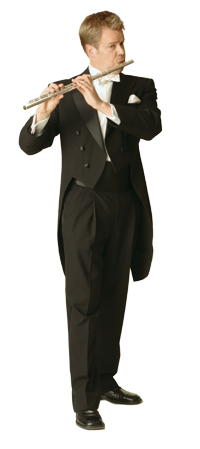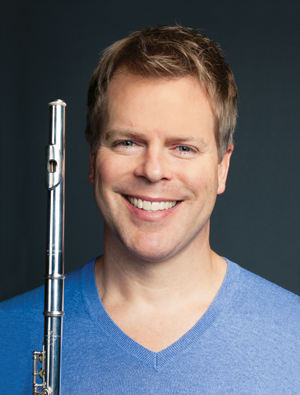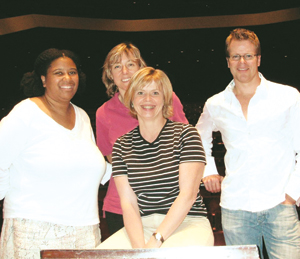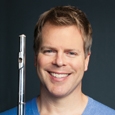 After playing professionally for the past 27 years, John Thorne joins the faculty of the Bienen School of Music at Northwestern University as Associate Professor of Flute this September. While he has taught throughout his performing career, his new primary focus will be on training the orchestral and solo flutists of tomorrow.
After playing professionally for the past 27 years, John Thorne joins the faculty of the Bienen School of Music at Northwestern University as Associate Professor of Flute this September. While he has taught throughout his performing career, his new primary focus will be on training the orchestral and solo flutists of tomorrow.
What were your early influences?
My earliest musical memory was listening to a recording of Ravel’s Daphnis and Chloe with my mother as a young child. I have often thought it was a great idea that she chose Daphnis as an introduction to symphonic music. She decided that starting with something more descriptive and colorful would be good for a young listener. I still love Ravel to this day.
I come from a family of theater people. By the age of five I was already acting on stage. My mother taught in the drama department at Juilliard when I was growing up, and I remember running around the third floor of Juilliard while she taught her acting class. I chose to play the flute because my favorite babysitter played the flute and showed me how to put the instrument together and make a sound. I took to it naturally, so when it was time to choose an instrument at school, I chose the flute.
When I was young, I was inspired by listening to Julius Baker and Jean-Pierre Rampal. After I started flute lessons, a neighbor lent me a recording of Baker playing the Vivaldi and Mozart concertos. I remember the day of the week, a Sunday, and the time of day, a sunny afternoon, when I first heard that recording. I knew then that I wanted to be a musician. When I was 14 years old, my mother bought me tickets to a series of masterclasses taught by Rampal in New York. I was just a member of the audience, but from my seat in the second row, I was able to watch him demonstrate how the flute should be played.
Do you have a favorite book you encourage flute students to read?
I think John Krell’s book Kincaidiana is a great resource. In this book, Krell explains the main concepts of William Kincaid’s teaching, drawn from his own experience as a former student and colleague of Kincaid’s (William Kincaid was principal flute of the Philadelphia Orchestra from 1921-1960 and the flute teacher at the Curtis Institute of Music from 1928 until the mid-1960s). Krell discusses not only the physical aspects of flute performance, such as proper hand position, embouchure placement and finger technique, but more significantly, he analyzes the technique of phrasing and control over the tone that allows a flutist to create not only a beautiful, varied sonority, but to communicate with an audience.
There are so many excellent books on flute technique, as well as daily exercises to build finger technique. Yet, there are few books that explain the art of phrasing. Too often phrasing is described only in adjectives, leaving young flutists confused as to what it is they are supposed to do physically with their air and embouchure. Krell describes in great detail how to prepare intervals, how to connect one note to the next, and through those skills how to create a seamless and dynamically varied line. Kincaid often described this approach to phrasing as playing between the notes. As a teacher, I feel that this is the most important skill to pass on to students, for it is what allows us to communicate with our audience.
What advice can you share about practicing daily exercises?
Tone exercises that work on speed of wind, dynamics, and preparation of intervals, not just beauty of tone, will help to develop the skills that Krell discusses in Kincaidiana. They will also develop the ability to play any note on the flute with any dynamic and color. This provides unlimited options to the performer as to how a phrase can be played. After the development of a beautiful, full sound, the freedom to place a note at any point within a musical phrase or line is the ultimate goal of tone exercises. Control over the tone allows flutists to paint a picture through sound for an audience. Unfortunately, this essential skill is too often overlooked in favor of building finger technique. Both skills are necessary to be a complete and successful musician.
Along with experimenting with tone and phrasing, it is important to develop dexterity and coordination of the hands and embouchure. Daily scale and intervallic work helps establish and maintain a strong connection between mind, body, and flute. I have always used the Seventeen Daily Exercises by Paul Taffanel & Philippe Gaubert, which I have played since I was eleven years old. These studies should be memorized, as they will accompany flutists through their careers as performers and teachers. These exercises not only develop a strong facility, but also a thorough knowledge of keys and intervals, which are the vocabulary of music. I have found in my own practice that daily work on these exercises is money in the bank. I prefer to play two octave scales in modes; I start on all degrees of the scale as in daily exercise number three (E.J.3). Often in a composition, a scale starts on a note other than the tonic. This approach is more time intensive, especially when we transpose scales into all major and minor keys. I have found that playing major scales one day and minor the next is more efficient.
The Taffanel and Gaubert Daily Exercises work best for me, but there are so many excellent technical exercise books available. It is also important, for variety and contrast, to work from different exercise books, so as not to become bored by the same routine. Different exercises will be more effective for different flutists, but serious flutists of all ages should spend forty-five minutes to an hour a day working on exercises for finger technique, articulation, and tone development. This strengthens a subconscious control over the instrument and frees flutists from having to think about how to execute a musical passage, allowing them to spontaneously conceive and execute what is heard in the imagination.
Do you assign etudes in your curriculum?
I am a strong believer in progressing through all of the Andersen Etudes (Op. 33, 30, 63, 15, 60) before studying the French etudes or Karg-Elert Caprices. Students who have studied the Andersen Etudes and worked on all the challenges they present will inevitably have a good, solid foundation for their technique. They will have covered all key areas, encountered all the intervallic, articulation, and velocity demands, and developed the necessary concentration and endurance to play through a long extended study. In my experience, a student that completes all of the Andersen Etudes first, especially upon finishing Andersen’s Twenty-Four Virtuosity Studies, Op. 60, is fully capable of meeting the challenges of the entire flute repertoire. Of course, these etudes do not cover many of the techniques developed in the twentieth-century. For those skills, Robert Dick and other contemporary flutists and composers have written many invaluable exercises, etudes, and compositions. The development of contemporary techniques should be done in conjunction with the Andersen Etudes, as young flutists should become comfortable with the demands of contemporary music sooner rather than later.
How can students learn to play in all styles?
I feel that it is important for students to study and listen to all types of music, not just classical, in order to develop an ear for different idioms and styles. It is through listening that we learn the various inflections and cadences of different genres of music. We all have a talent for language and accent that is innate when we are young. Musicians should maintain this skill, so they can learn various styles with the same fluency and ease as children learn languages. Teachers should work with students so they develop an ear for nuance. Music, though notated, is still essentially an aural tradition. It needs to be heard in order for the performer to know the correct approach to style. There is no manner of notation that can effectively provide all the correct nuances. It is through careful listening and imitation that musicians learn to play in a jazz idiom as well as in the Baroque style.
Students should also have a sense of context within which to fit different styles of music. For example, I encourage students to learn not just the flute part in Debussy’s Afternoon of a Faun, but also to read the Mallarme poem that inspired Debussy, as well as see Nijinsky’s choreography that Debussy’s composition inspired. In addition, students should know not just what the Baroque and Classical styles are, but what their cultural roots were. To help a young flutist develop into a musician, and hopefully into an artist, a love of the humanities must be encouraged and developed. Practice can provide a young flutist with technique, but exposure to all performing and visual arts, as well as study of the humanities, will give them something to say.
How does a flutist develop inflection?
In my own teaching, I often find that it is helpful to analyze the inflection that we use in everyday speech as a way to remind students that music is also a language and should have just as much variety of expression and inflection. For it is this variety that serves as a constantly changing flow of sound that can keep an audience captivated. A monotonous flow of even-tempered tones, even if well produced, will not interest an audience through a long composition. A constantly shifting variety of tone, color, and inflection within a phrase can fascinate the ear. Too often flutists resort to physical mannerisms in order to keep an audience’s attention (often producing tension within the body), instead of using inflection, control of tone colors, and phrasing to communicate the emotional content of a piece. Listeners should be able to close their eyes and hear, as well as see, the music. They should not have to see the performer to hear their phrasing.
 How does a flutist develop projection and a beautiful sound?
How does a flutist develop projection and a beautiful sound?
I grew up just outside of New York City and had a neighbor who was a member of the New York Philharmonic. He often gave me free tickets to concerts as well as a ride down to Manhattan. I spent my high school years listening to Julius Baker play in the orchestra, both live as well as on recordings and radio broadcasts. His beauty of tone and the way his sound projected in the hall highly influenced me. So many people feel that you must play forte all the time in order to project. I learned from Baker, however, that it is more important to focus the sound. A compact tone that is centered also has a density that makes it project more than a tone that is diffuse. It is the speed of wind and energy within the tone that makes the sound spin and travel out into the hall. It is also important to allow more air to travel into the headjoint by not covering too much of the lip plate. Julius played with a very open sound, as did his colleague Joseph Mariano (professor of flute at the Eastman School of Music from 1935-1974 and principal flute of the Rochester Philharmonic). Baker often said that you had to let the flute play itself. He was very efficient in his physical approach to the instrument. My mother used to remark that he looked like a Buddha when he played because he was relaxed and at ease, even during the most difficult passages. Regardless of the many highly individual tastes about color and timbre, it is a relaxed, centered and open sound that, when combined with a high speed of wind, will project naturally.
What other musicians influenced your musical development?
After studying at Curtis, I studied privately with Anne Diener Zentner, the former principal flute of the Los Angeles Philharmonic. She taught me how to take the phrasing skills I had learned from John Krell and more directly apply them to a composition. She had me choose a focal point within a phrase and then link phrases together within the larger structure, the architecture of a composition. Awareness of the overall structure of a composition is essential in being able to communicate with an audience. Listeners may be hearing a piece for the first time, but they can relate to the building and release of tension inherent in most compositions. Anne Zentner taught me how to direct a phrase to its focal point, which if prepared adequately will be desired by the listener. Linking one phrase to another creates ever-larger phrase groupings that rise up and down and culminate in the climax of a movement or composition.
I have also been influenced by listening to other instruments and singers. My favorite pianist is Martha Argerich. I encourage students to listen to her recordings and if possible to hear her live. Her command of the instrument is ideal, but it is her musicianship that is most compelling. The variety of color and inflection, the phrasing, and the effect on the listener is one of the most moving experiences I’ve ever had as a listener. Her recording of Ravel’s Gaspard de la Nuit is one of my favorite recordings. The first movement, Ondine, is a perfect example of the use of color, as well as building and release of tension within a movement.
What have you learned from your orchestral experiences?
After finishing my studies, I was a member of The New World Symphony. This was during the first full season of the orchestra, when everything was just beginning. It was an exciting time. In 1988 Michael Tilson Thomas had the foresight to establish a training orchestra for young musicians who were just beginning their careers. Things were not as upscale back then as they are now. Back then the New World Symphony did not even have a hall in which to rehearse. We used a nearby community center, carpeting and all. I was so glad to be making a living playing in an orchestra and doing what I had always dreamed of, however, none of that mattered.
There are many orchestral musicians around the world who have benefitted greatly from Michael Tilson Thomas’s vision and commitment to building the New World Symphony. He saw the opportunity in the revitalization of Miami Beach to help develop the growing arts scene. I learned a lot from working with Michael. Besides the support and encouragement that Michael gave me as a young professional, he taught us to look towards the future. He is willing to try new things and experiment to connect with the classical music audience of today. The name he chose for the orchestra says it all: it is an orchestral training ground for a new world. I will always be grateful for the experience and opportunities the New World Symphony gave me.
 It was a hard decision to leave the New World Symphony after just one season, but I was offered the principal flute position in what is now the Sarasota Orchestra. It wasn’t easy to give up all that the New World Symphony provided in order to join a smaller organization, but I decided that if I wanted to be a professional orchestral flutist I had to follow the path that I was given. Luckily, it was a period of time in which there were many professional flute auditions. For the next year and half, while playing in the orchestra in Sarasota, I took all the principal flute auditions. I started getting into the final rounds and that gave me the confidence to proceed. I focused on learning how to take an audition. You can learn a lot waiting backstage. I had the opportunity to hear some great players and learn from watching them audition.
It was a hard decision to leave the New World Symphony after just one season, but I was offered the principal flute position in what is now the Sarasota Orchestra. It wasn’t easy to give up all that the New World Symphony provided in order to join a smaller organization, but I decided that if I wanted to be a professional orchestral flutist I had to follow the path that I was given. Luckily, it was a period of time in which there were many professional flute auditions. For the next year and half, while playing in the orchestra in Sarasota, I took all the principal flute auditions. I started getting into the final rounds and that gave me the confidence to proceed. I focused on learning how to take an audition. You can learn a lot waiting backstage. I had the opportunity to hear some great players and learn from watching them audition.
After a year and half in Sarasota, I won the principal flute position in the San Antonio Symphony. I had never been to Texas before the audition. San Antonio is a charming city and I loved the Hill Country just outside the city. My colleagues in San Antonio were wonderful and I had a great time. After six months, I won the associate principal position in the Houston Symphony. I finished out the season in San Antonio and moved to Houston, where I have been for the past twenty years. (Pictured: The Houston Symphony flute section in 2006. (from left to right) Judith Dines, Aralee Dorough, Cynthia Meyers, and John Thorne.)
What is your teaching philosophy?
It is important to create an environment that encourages students to experiment, take risks, fail, learn from failure, succeed, and commit to being a better musician every day. I believe teaching should be collaborative, with the student learning from the teacher, and the teacher learning from the student. The studio should be a positive and encouraging place where students feel free to experiment with their approach to the flute and musicianship. It is important to develop standards and goals while also allowing students to find their own way. The teacher is only a guide to help draw out the best within each student; the student has to do the hard work of developing the ideas presented to them. A creative environment is essential for allowing students to do their best work. I have been very fortunate to study with many excellent and dedicated teachers, and I feel that it is my responsibility to pass on to others what my teachers so tirelessly and enthusiastically gave to me.
What are your goals for the studio?
It is a pleasure to join the faculty at Northwestern. Walfrid Kujala and Richard Graef have built a great studio and now that Professor Kujala is retiring, Richard Graef and I will be working to build upon the impact that Kujala’s teaching has had on flute pedagogy.
The Bienen School of Music is committed to training young professionals to meet the changing demands of the music industry. The goal is to provide students with the tools that will allow them to respond to a rapidly changing economic and cultural landscape. I want to pass on what I have learned over 27 years of playing professionally in orchestras and in chamber music groups. It is very gratifying to help students and young professionals achieve their goals and I feel fortunate to work with such talented students at Northwestern.
* * *
 John Thorne joins the faculty of Northwestern University’s Bienen School of Music as an associate professor of flute this September. He has been the associate principal flute of the Houston Symphony since 1992. Previously, he was principal flute with the San Antonio Symphony and the Florida West Coast Symphony (now called the Sarasota Orchestra). He started his career as a member of the inaugural season of the New World Symphony.
John Thorne joins the faculty of Northwestern University’s Bienen School of Music as an associate professor of flute this September. He has been the associate principal flute of the Houston Symphony since 1992. Previously, he was principal flute with the San Antonio Symphony and the Florida West Coast Symphony (now called the Sarasota Orchestra). He started his career as a member of the inaugural season of the New World Symphony.
Thorne received his Bachelor of Music from the Curtis Institute of Music, where he was a student of Julius Baker and John Krell, former piccolo player of the Philadelphia Orchestra. Upon graduation from Curtis, Thorne studied privately with Anne Diener Zentner, former principal flute of the Los Angeles Philharmonic. He received his Master of Music from Michigan State University, where he was part of the Halyburton Wind Quintet.
Thorne taught at the University of Houston’s Moores School of Music from 1994 to 2002 as an adjunct faculty member. In addition to teaching privately, he has given masterclasses in Texas for the Houston Flute Club, Austin Flute Club and at the University of Texas, Austin. He has also served on juries for flute competitions in the Houston area as well as for the NFA’s Young Artist Competition.






